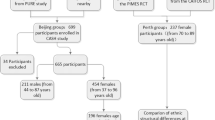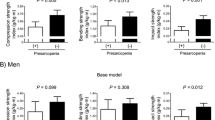Abstract
Compressive strength index (CSI) of the femoral neck is a parameter that integrates the information of bone mineral density (BMD), femoral neck width (FNW), and body weight. CSI is considered to have the potential to improve the performance of assessment for hip fracture risk. However, studies on CSI have been rare. In particular, few studies have evaluated the performance of CSI, in comparison with BMD, FNW, and bending geometry, for assessment of hip fracture risk. We studied two large populations, including 1683 unrelated U.S. Caucasians and 2758 unrelated Chinese adults. For all the study subjects, CSI, femoral neck BMD (FN_BMD), FNW, and bending geometry (section modulus [Z]) of the samples were obtained from dual-energy X-ray absorptiometry scans. We investigated the age-related trends of these bone phenotypes and potential sex and ethnic differences. We further evaluated the performance of these four phenotypes for assessment of hip fracture risk by logistic regression models. Chinese had significantly lower FN_BMD, FNW, and Z, but higher CSI than sex-matched Caucasians. Logistic regression analysis showed that higher CSI was significantly associated with lower risk of hip fracture, and the significance remained after adjusting for covariates of age, sex, and height. Each standard deviation (SD) increment in CSI was associated with odds ratios of 0.765 (95% confidence interval, 0.634, 0.992) and 0.724 (95% confidence interval, 0.569, 0.921) for hip fracture risk in Caucasians and Chinese, respectively. The higher CSI in Chinese may partially help explain the lower incidence of hip fractures in this population compared to Caucasians. Further studies in larger cohorts and/or longitudinal observations are necessary to confirm our findings.



Similar content being viewed by others
References
Cummings SR, Karpf DB, Harris F, Genant HK, Ensrud K, LaCroix AZ, Black DM (2002) Improvement in spine bone density and reduction in risk of vertebral fractures during treatment with antiresorptive drugs. Am J Med 112:281–289
Lauritzen JB (1997) Hip fractures. Epidemiology, risk factors, falls, energy absorption, hip protectors, and prevention. Dan Med Bull 44:155–168
Genant HK, Grampp S, Gluer CC, Faulkner KG, Jergas M, Engelke K, Hagiwara S, Van Kuijk C (1994) Universal standardization for dual X-ray absorptiometry: patient and phantom cross-calibration results. J Bone Miner Res 9:1503–1514
Kanis JA, McCloskey EV, Johansson H, Oden A, Melton LJ 3rd, Khaltaev N (2008) A reference standard for the description of osteoporosis. Bone 42:467–475
Siris ES, Chen YT, Abbott TA, Barrett-Connor E, Miller PD, Wehren LE, Berger ML (2004) Bone mineral density thresholds for pharmacological intervention to prevent fractures. Arch Intern Med 164:1108–1112
Stone KL, Seeley DG, Lui LY, Cauley JA, Ensrud K, Browner WS, Nevitt MC, Cummings SR (2003) BMD at multiple sites and risk of fracture of multiple types: long-term results from the Study of Osteoporotic Fractures. J Bone Miner Res 18:1947–1954
Babbar RK, Handa AB, Lo CM, Guttmacher SJ, Shindledecker R, Chung W, Fong C, Ho-Asjoe H, Chan-Ting R, Dixon LB (2006) Bone health of immigrant Chinese women living in New York City. J Community Health 31:7–23
Lau EM, Lynn H, Woo J, Melton LJ 3rd (2003) Areal and volumetric bone density in Hong Kong Chinese: a comparison with Caucasians living in the United States. Osteoporos Int 14:583–588
Roy D, Swarbrick C, King Y, Pye S, Adams J, Berry J, Silman A, O’Neill T (2005) Differences in peak bone mass in women of European and South Asian origin can be explained by differences in body size. Osteoporos Int 16:1254–1262
Black DM, Bouxsein ML, Marshall LM, Cummings SR, Lang TF, Cauley JA, Ensrud KE, Nielson CM, Orwoll ES (2008) Proximal femoral structure and the prediction of hip fracture in men: a large prospective study using QCT. J Bone Miner Res 23:1326–1333
Bergot C, Bousson V, Meunier A, Laval-Jeantet M, Laredo JD (2002) Hip fracture risk and proximal femur geometry from DXA scans. Osteoporos Int 13:542–550
Calis HT, Eryavuz M, Calis M (2004) Comparison of femoral geometry among cases with and without hip fractures. Yonsei Med J 45:901–907
Faulkner KG, Cummings SR, Black D, Palermo L, Gluer CC, Genant HK (1993) Simple measurement of femoral geometry predicts hip fracture: the study of osteoporotic fractures. J Bone Miner Res 8:1211–1217
Karlsson KM, Sernbo I, Obrant KJ, Redlund-Johnell I, Johnell O (1996) Femoral neck geometry and radiographic signs of osteoporosis as predictors of hip fracture. Bone 18:327–330
Michelotti J, Clark J (1999) Femoral neck length and hip fracture risk. J Bone Miner Res 14:1714–1720
Brownbill RA, Ilich JZ (2003) Hip geometry and its role in fracture: what do we know so far? Curr Osteoporos Rep 1:25–31
Karlamangla AS, Barrett-Connor E, Young J, Greendale GA (2004) Hip fracture risk assessment using composite indices of femoral neck strength: the Rancho Bernardo Study. Osteoporos Int 15:62–70
Xiong DH, Shen H, Zhao LJ, Xiao P, Yang TL, Guo Y, Wang W, Guo YF, Liu YJ, Recker RR, Deng HW (2006) Robust and comprehensive analysis of 20 osteoporosis candidate genes by very high-density single-nucleotide polymorphism screen among 405 white nuclear families identified significant association and gene–gene interaction. J Bone Miner Res 21:1678–1695
Xiao P, Shen H, Guo YF, Xiong DH, Liu YZ, Liu YJ, Zhao LJ, Long JR, Guo Y, Recker RR, Deng HW (2006) Genomic regions identified for BMD in a large sample including epistatic interactions and gender-specific effects. J Bone Miner Res 21:1536–1544
Deng HW, Shen H, Xu FH, Deng HY, Conway T, Zhang HT, Recker RR (2002) Tests of linkage and/or association of genes for vitamin D receptor, osteocalcin, and parathyroid hormone with bone mineral density. J Bone Miner Res 17:678–686
Rivadeneira F, Houwing-Duistermaat JJ, Beck TJ, Janssen JA, Hofman A, Pols HA, Van Duijn CM, Uitterlinden AG (2004) The influence of an insulin-like growth factor I gene promoter polymorphism on hip bone geometry and the risk of nonvertebral fracture in the elderly: the Rotterdam Study. J Bone Miner Res 19:1280–1290
Duan Y, Beck TJ, Wang XF, Seeman E (2003) Structural and biomechanical basis of sexual dimorphism in femoral neck fragility has its origins in growth and aging. J Bone Miner Res 18:1766–1774
Malkin I, Ginsburg E (2003) Program package for Mendelian analysis of pedigree data (MAN, version 6 technical report). Tel Aviv: Tel Aviv University, Department of Anatomy and Anthropology
Malkin I, Karasik D, Livshits G, Kobyliansky E (2002) Modelling of age-related bone loss using cross-sectional data. Ann Hum Biol 29:256–270
Omsland TK, Schei B, Gronskag AB, Langhammer A, Forsen L, Gjesdal CG, Meyer HE (2009) Weight loss and distal forearm fractures in postmenopausal women: the Nord-Trondelag Health Study, Norway. Osteoporos Int 20:2009–2016
Meyer HE, Sogaard AJ, Falch JA, Jorgensen L, Emaus N (2008) Weight change over three decades and the risk of osteoporosis in men: the Norwegian Epidemiological Osteoporosis Studies (NOREPOS). Am J Epidemiol 168:454–460
van der Voort DJ, Geusens PP, Dinant GJ (2001) Risk factors for osteoporosis related to their outcome: fractures. Osteoporos Int 12:630–638
Wu XP, Liao EY, Huang G, Dai RC, Zhang H (2003) A comparison study of the reference curves of bone mineral density at different skeletal sites in native Chinese, Japanese, and American Caucasian women. Calcif Tissue Int 73:122–132
Bhudhikanok GS, Wang MC, Eckert K, Matkin C, Marcus R, Bachrach LK (1996) Differences in bone mineral in young Asian and Caucasian Americans may reflect differences in bone size. J Bone Miner Res 11:1545–1556
Cundy T, Cornish J, Evans MC, Gamble G, Stapleton J, Reid IR (1995) Sources of interracial variation in bone mineral density. J Bone Miner Res 10:368–373
Taaffe DR, Lang TF, Harris TB (2003) Poor correlation of mid-femoral measurements by CT and hip measurements by DXA in the elderly. Aging Clin Exp Res 15:131–135
Seeman E, Duan Y, Fong C, Edmonds J (2001) Fracture site-specific deficits in bone size and volumetric density in men with spine or hip fractures. J Bone Miner Res 16:120–127
Alonso CG, Curiel MD, Carranza FH, Cano RP, Perez AD (2000) Femoral bone mineral density, neck-shaft angle and mean femoral neck width as predictors of hip fracture in men and women. Multicenter Project for Research in Osteoporosis. Osteoporos Int 11:714–720
Filardi S, Zebaze RM, Duan Y, Edmonds J, Beck T, Seeman E (2004) Femoral neck fragility in women has its structural and biomechanical basis established by periosteal modeling during growth and endocortical remodeling during aging. Osteoporos Int 15:103–107
Rivadeneira F, Zillikens MC, De Laet CE, Hofman A, Uitterlinden AG, Beck TJ, Pols HA (2007) Femoral neck BMD is a strong predictor of hip fracture susceptibility in elderly men and women because it detects cortical bone instability: the Rotterdam Study. J Bone Miner Res 22:1781–1790
Kaptoge S, Beck TJ, Reeve J, Stone KL, Hillier TA, Cauley JA, Cummings SR (2008) Prediction of incident hip fracture risk by femur geometry variables measured by hip structural analysis in the study of osteoporotic fractures. J Bone Miner Res 23:1892–1904
Acknowledgments
Investigators of this work were partially supported by Grants from the NIH (R01 AR050496, R21 AG027110, R01 AG026564, P50 AR055081, and R21 AA015973). The study also benefited from grants from National Science Foundation of China, Huo Ying Dong Education Foundation, HuNan Province, and the Ministry of Education of China. We are grateful to Kirk Redger for editing help.
Disclosures
None.
Author information
Authors and Affiliations
Corresponding authors
Additional information
Na Yu and Yong-Jun Liu were co-first authors.
The authors have stated that they have no conflict of interest.
Electronic supplementary material
Below is the link to the electronic supplementary material.
Fig. 1
Properties of compressive strength index (CSI) distribution before and after adjustment for age and by sex in Caucasians. Mean is the average value of CSI; Std. Dev. is the standard deviation; N is the total number in plot. Supplementary material 1 (TIFF 382 kb)
Fig. 2
Properties of compressive strength index (CSI) distribution before and after adjustment for age and by sex in Chinese. Mean is the average value of CSI; Std. Dev. is the standard deviation; N is the total number in plot. Supplementary material 2 (TIFF 355 kb)
Rights and permissions
About this article
Cite this article
Yu, N., Liu, YJ., Pei, Y. et al. Evaluation of Compressive Strength Index of the Femoral Neck in Caucasians and Chinese. Calcif Tissue Int 87, 324–332 (2010). https://doi.org/10.1007/s00223-010-9406-8
Received:
Accepted:
Published:
Issue Date:
DOI: https://doi.org/10.1007/s00223-010-9406-8




